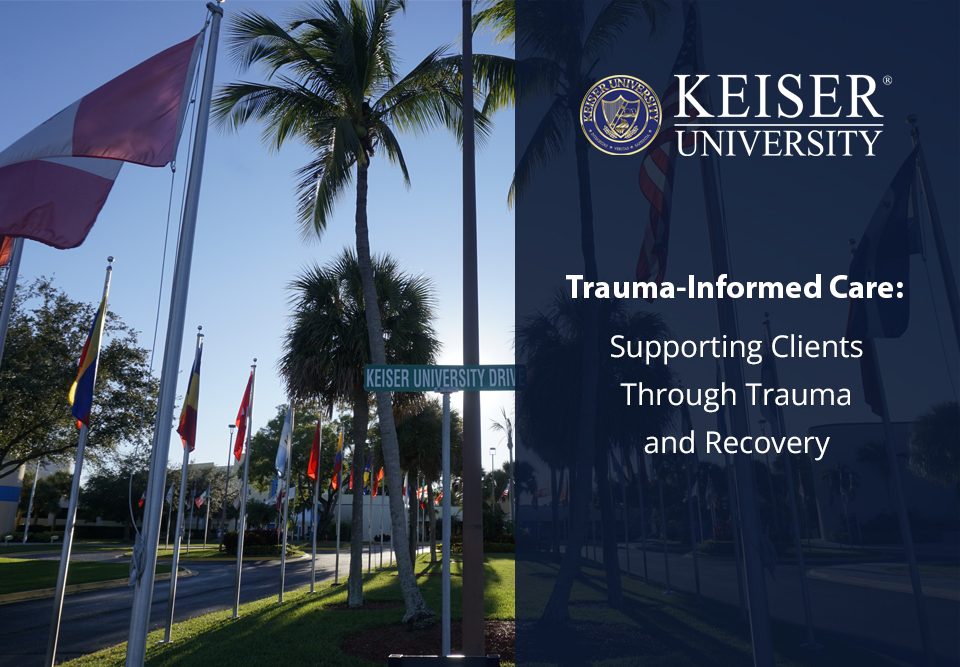Trauma can shape our inner worlds, relationships and communities. Like it or not, it is often an impactful component of the human experience. Research suggests that 70 percent of adults have experienced some form of trauma. However, when this causes ongoing distress or stands the way of day-to-day functioning, trauma-informed care is essential. Keep reading to learn how this works and which technique are most impactful.

Understanding Trauma and Its Impact
Extremely stressful or frightening incidents prompt an emotional outcome known as trauma. The American Psychological Association (APA) highlights shock and denial as some of the most common short-term effects, followed by a variety of long-term mental, emotional or even physical concerns.
Numerous studies makes it abundantly clear that trauma has an outsized impact on every aspect of daily life, including thoughts, feelings, behaviors and relationships. While specific manifestations of trauma can look dramatically different from one person to the next, it typically has a detrimental impact on the areas of the brain responsible for emotional regulation and executive functioning. This can lead to ongoing feelings of distress, along with harmful coping mechanisms and even acute physical symptoms.
In-depth research on Adverse Childhood Experiences (ACEs) provide especially concerning insight into the long-term impacts of trauma, revealing that childhood trauma can lead to a variety of adverse outcomes throughout the entire lifespan.
What Is Trauma-Informed Care?
Trauma-informed care is a powerful framework that acknowledges the dramatic role life experiences can play not only in feelings and behaviors, but also in efforts to grow and recover. When done right, this approach can boost client engagement and lead to positive outcomes including long-term trauma recovery.
Identifying Types of Traumas
Trauma can take many forms. While research and care have traditionally focused on brief, but highly distressing events such as car crashes, acts of violence or natural disasters, it’s increasingly evident that other forms of trauma can also be harmful.
The Substance Abuse and Mental Health Services Administration (SAMHSA) resource Trauma-Informed Care in Behavioral Health Services highlights the differences between natural and human-caused traumas, revealing that natural events or “acts of God” (such as storms) are generally unavoidable, while human-caused traumas (involving war, abuse or negligence) may be more impactful if they are perceived as intentional.
Exploring the Effects of Trauma
We have provided a brief overview of the extensive damage that trauma can cause both on a short and long-term basis. Now, we will take a deeper dive into these concerns:
Emotional Effects
In the immediate aftermath of traumatic events, victims may experience a whirlwind of strong emotions, ranging from terror to sadness or even anger. That said, in some, dissociation or numbness may occur. Unfortunately, problematic emotions do not always subside with time and may come back to the surface during especially stressful moments.
Psychological Effects
A wide range of mental health disorders are strongly linked to trauma. Post-traumatic stress disorder (PTSD) may come to mind, but that is just the beginning. Trauma can dramatically increase the likelihood of suffering the symptoms of depression, anxiety and eating disorders. Many victims of trauma report persistently elevated stress levels, along with acute concerns such as flashbacks.
Physical Effects
Those who have experienced trauma often report physical symptoms such as:
- Increases in heart rate and blood pressure
- Headaches
- Difficulty sleeping
- Changes in appetite
These symptoms can play into a variety of long-term health issues. For example, trauma is believed to activate various immune and inflammatory responses, which can predispose sufferers to allergies, asthma and other chronic health concerns. Similarly, ongoing issues with heart rate or blood pressure may make the victims of trauma more susceptible to cardiovascular disease.
Principles of Trauma-Informed Care
Trauma-informed care is guided by several core principles, which encourage professionals to create environments conducive to healing. Identified by SAMHSA, these principles must be top of mind when treating clients who have been impacted by traumatic events.
Safety: Creating a Safe Environment for Clients
Clients must feel confident that, during counseling sessions, they are both physically and emotionally safe. As a study published in the Clinical Neuropsychiatry Journal of Treatment Evaluation reveals, many of today’s most impactful counseling theories point to empathy and authenticity as critical elements of any safe environment. Non-judgmental treatment is also a must.
Trustworthiness: Building Trust and Establishing Boundaries
Patients can feel safe without trusting their counselors, but both qualities are essential. In the therapeutic context, trust involves the expectation that the well-being of the client will be a priority and that all actions or interventions will serve to support the client’s well-being. This also encompasses transparency as person-centered theories reveal that clients do not want to feel as if they’ve been deceived by their counselors.
Empowerment: Fostering Client Autonomy and Choice
To achieve lasting recovery, clients need to truly believe that they can guide this process while drawing from a wellspring of inner strength and wisdom. Over time, clients should move beyond feelings of helplessness and work toward mastering techniques and strategies that they can implement on their own in times of distress.
Implementing Trauma-Informed Practices
Success in trauma-informed care begins with understanding the far-reaching impact of trauma and centering treatment efforts around this understanding. From there, therapeutic techniques should be chosen based on how well they align with trauma-informed best practices. Simply put, some strategies are not helpful for — or may even be actively detrimental to — patients who have suffered trauma.
Strategies for Integrating Trauma-Informed Care
The National Child Traumatic Stress Network identifies trauma-informed integrated healthcare as a structured approach to preventing, recognizing and responding to “trauma-related difficulties through collaboration of physical and mental health professionals.” This relies heavily on the efforts of mental health professionals, who can ensure that clients are properly diagnosed and that they have access to necessary resources.
Screening and Assessment: Identifying Histories and Needs
Trauma-informed care begins with the screening process. This allows counselors to determine the nature and the severity of the trauma. Multiple tools and models are available to guide the clinical trauma patient assessment process. Common examples include the Child Welfare Trauma Referral Tool and the Trauma Assessment Pathway.
As SAMHSA resources explain, the primary goals of screening are to determine “whether the person has a history of trauma and whether he or she has trauma-related symptoms.” From there, in-depth assessments define “presenting struggles to develop an appropriate treatment plan.”
Trauma-Sensitive Interventions: Evidence-Based Approaches
Following screening, assessment and diagnosis, counselors can develop and implement treatment plans centered around evidence-based modalities. These may fall within the scope of prominent counseling theories, such as:
- Cognitive-behavioral therapy
- Dialectical behavior therapy
- Adaptive information processing
Addressing Vicarious Trauma and Self-Care
Traumatized clients can have a discernible impact on the passionate counselors who specialize in trauma-informed care. Sometimes referred to as secondary traumatic stress, this phenomenon must be acknowledged and addressed to limit stress and reduce the potential for professional burnout.
Impact of Vicarious Trauma
Vicarious trauma is a significant risk among those who work extensively with traumatized clients. This often manifests in a preoccupation with clients’ situations. Affected counselors may experience overwhelming sadness or anger to the point that they struggle to function at work or in their personal lives. In severe cases, vicarious trauma can lead to full-blown mental health concerns such as depression or substance abuse.
Understanding the Signs and Symptoms
The signs of vicarious trauma often reflect the typical symptoms of burnout, such as fatigue (both physical and mental), irritability, cynicism or hopelessness. With vicarious trauma, rumination often enters the picture and counseling professionals may feel preoccupied with their clients’ issues when they’re away from the workplace.
Developing Self-Care Strategies
Self-care is a must in any profession that calls for significant emotional labor. This can take many forms but involves any strategy that places the emotional needs of the counselor first. Common strategies include:
- Set boundaries. While counselors encourage clients to set boundaries, some struggle to implement this in their own lives. This begins with creating detailed contracts referencing timing, finances and scope of practice. Boundaries may also call for enforcement, like prioritizing punctuality and avoiding the urge to extend therapy sessions beyond their established times.
- Consider seeking therapy. Many of the most knowledgeable and effective counselors actively seek out therapy. This can serve many purposes, such as dealing with vicarious trauma, or even remaining connected to the client experience.
- Emphasize physical health. Busy counselors sometimes struggle to maintain healthy dietary and exercise habits. These are essential forms of self-care. Exercise boosts endorphins, while excessive consumption of processed foods is linked to symptoms of depression and other mental health concerns.
Promoting Resilience and Recovery
Defined by the APA as “successfully adapting to difficult or challenging life experiences,” resilience can limit suffering in those who have experienced trauma. Counseling can play heavily in this effort. Resilience-building strategies may vary between therapeutic modalities, but research suggests that cognitive behavioral therapy (CBT), in particular, can boost resilience while also reducing the likelihood of relapse.
Interventions designed to improve resilience include mindfulness, solution-focused coaching and active coping. Clients also learn to reframe their traumatic experiences by accepting situations that cannot be changed and moving away from damaging thought patterns involving polarized thinking and overgeneralization.
Supporting Clients on Their Journeys
Resilience should be regarded as a process, rather than a permanent or inborn trait. This can be developed over time, but it may take months of commitment to therapy before clients (especially those with a history of trauma) can successfully bounce back from challenges. Counselors should support clients through their journeys, pointing to signs of progress while continuing to encourage them to take ownership of their recovery.
Building Resilience via Strengths-Based Approaches
Strengths-based therapy promotes lasting recovery by accentuating the positive. This approach was pioneered by Donald O. Clifton, who has expressed a “reinforcing [clients’] greatest strengths, rather than on highlighting their weaknesses.” Furthermore, this approach acknowledges that the victims of trauma can not only survive adversity but can grow by leveraging its difficult lessons.
Ongoing Support and Resources for Long-Term Recovery
Treatment durations differ considerably depending on the modality, techniques and the nature of the client’s difficulties. With trauma, longer durations may prove necessary, with many clients advised to continue treatment for at least one year. Ultimately, trauma-informed care seeks to equip them with the diverse skills and resources they need to promote long-term recovery.
Clients will know they are on the way to recovery once they have reached a sense of calm and stability. Recovery also means living in the present without feeling debilitated by ruminations about trauma. Difficult emotions will still arise, but when they do, clients will know how to implement effective strategies for combating unhelpful thought patterns. In the interim, recovered clients often report that they suffer fewer flashbacks.
Of course, clients should also know that counseling always remains within reach if symptoms return. Re-traumatization and recurrence are always possibilities, but clients can take comfort in knowing that therapeutic interventions are always within reach.
How You Can Promote Resilience as a Mental Health Counselor
Are you committed to helping clients work through their trauma to achieve greater emotional well-being? If so, you could have a bright future in mental health counseling. This is a compelling field for empathetic individuals who feel driven to help others.
Keiser University can help prepare you for a passion-driven professional journey. Our Master of Science in Clinical Mental Health Counseling will provide plenty of guidance and support as you develop necessary diagnostic and intervention skills. This is one of many compelling graduate programs we offer. That said, the Master of Science in Occupational Therapy is also a great option for preparing to facilitate growth and healing. Take the next step and connect with a graduate admissions counselor.






 The instructors at Keiser University impacted my life. They believed in my ability to become a great graphic designer, regardless of how I felt about my skills. KU helped to prepare me for the real world and got me to where I am today.
The instructors at Keiser University impacted my life. They believed in my ability to become a great graphic designer, regardless of how I felt about my skills. KU helped to prepare me for the real world and got me to where I am today.
